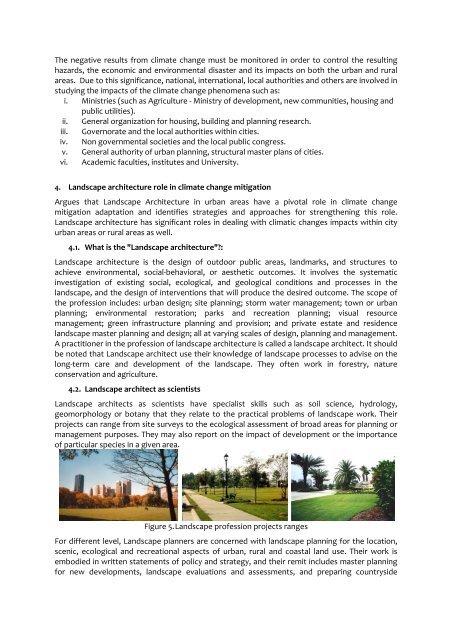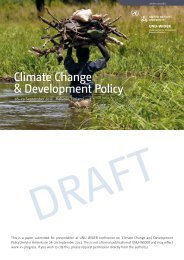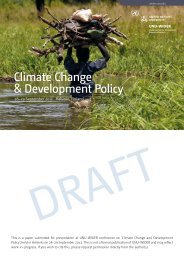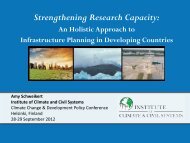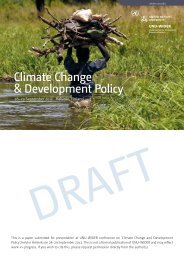Landscape architecture role in mitigating negative ... - UNU-WIDER
Landscape architecture role in mitigating negative ... - UNU-WIDER
Landscape architecture role in mitigating negative ... - UNU-WIDER
Create successful ePaper yourself
Turn your PDF publications into a flip-book with our unique Google optimized e-Paper software.
The <strong>negative</strong> results from climate change must be monitored <strong>in</strong> order to control the result<strong>in</strong>g<br />
hazards, the economic and environmental disaster and its impacts on both the urban and rural<br />
areas. Due to this significance, national, <strong>in</strong>ternational, local authorities and others are <strong>in</strong>volved <strong>in</strong><br />
study<strong>in</strong>g the impacts of the climate change phenomena such as:<br />
i. M<strong>in</strong>istries (such as Agriculture ‐ M<strong>in</strong>istry of development, new communities, hous<strong>in</strong>g and<br />
public utilities).<br />
ii. General organization for hous<strong>in</strong>g, build<strong>in</strong>g and plann<strong>in</strong>g research.<br />
iii. Governorate and the local authorities with<strong>in</strong> cities.<br />
iv. Non governmental societies and the local public congress.<br />
v. General authority of urban plann<strong>in</strong>g, structural master plans of cities.<br />
vi. Academic faculties, <strong>in</strong>stitutes and University.<br />
4. <strong>Landscape</strong> <strong>architecture</strong> <strong>role</strong> <strong>in</strong> climate change mitigation<br />
Argues that <strong>Landscape</strong> Architecture <strong>in</strong> urban areas have a pivotal <strong>role</strong> <strong>in</strong> climate change<br />
mitigation adaptation and identifies strategies and approaches for strengthen<strong>in</strong>g this <strong>role</strong>.<br />
<strong>Landscape</strong> <strong>architecture</strong> has significant <strong>role</strong>s <strong>in</strong> deal<strong>in</strong>g with climatic changes impacts with<strong>in</strong> city<br />
urban areas or rural areas as well.<br />
4.1. What is the "<strong>Landscape</strong> <strong>architecture</strong>":<br />
<strong>Landscape</strong> <strong>architecture</strong> is the design of outdoor public areas, landmarks, and structures to<br />
achieve environmental, social‐behavioral, or aesthetic outcomes. It <strong>in</strong>volves the systematic<br />
<strong>in</strong>vestigation of exist<strong>in</strong>g social, ecological, and geological conditions and processes <strong>in</strong> the<br />
landscape, and the design of <strong>in</strong>terventions that will produce the desired outcome. The scope of<br />
the profession <strong>in</strong>cludes: urban design; site plann<strong>in</strong>g; storm water management; town or urban<br />
plann<strong>in</strong>g; environmental restoration; parks and recreation plann<strong>in</strong>g; visual resource<br />
management; green <strong>in</strong>frastructure plann<strong>in</strong>g and provision; and private estate and residence<br />
landscape master plann<strong>in</strong>g and design; all at vary<strong>in</strong>g scales of design, plann<strong>in</strong>g and management.<br />
A practitioner <strong>in</strong> the profession of landscape <strong>architecture</strong> is called a landscape architect. It should<br />
be noted that <strong>Landscape</strong> architect use their knowledge of landscape processes to advise on the<br />
long‐term care and development of the landscape. They often work <strong>in</strong> forestry, nature<br />
conservation and agriculture.<br />
4.2. <strong>Landscape</strong> architect as scientists<br />
<strong>Landscape</strong> architects as scientists have specialist skills such as soil science, hydrology,<br />
geomorphology or botany that they relate to the practical problems of landscape work. Their<br />
projects can range from site surveys to the ecological assessment of broad areas for plann<strong>in</strong>g or<br />
management purposes. They may also report on the impact of development or the importance<br />
of particular species <strong>in</strong> a given area.<br />
Figure 5. <strong>Landscape</strong> profession projects ranges<br />
For different level, <strong>Landscape</strong> planners are concerned with landscape plann<strong>in</strong>g for the location,<br />
scenic, ecological and recreational aspects of urban, rural and coastal land use. Their work is<br />
embodied <strong>in</strong> written statements of policy and strategy, and their remit <strong>in</strong>cludes master plann<strong>in</strong>g<br />
for new developments, landscape evaluations and assessments, and prepar<strong>in</strong>g countryside


